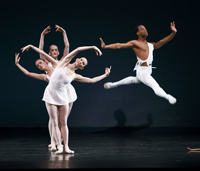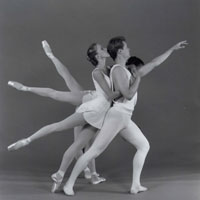

Choreography: George Balanchine
Music: Igor Stravinsky
In 1928 in Paris, Serge Diaghilev, a renown figure in the art world and director of the Les Ballets Russe (The Russian Ballet) brought together two young Russians. George Balanchine, a choreographer, and Igor Stravinsky, a composer, went on to become two of the greatest figures in their fields during the 20th century. One of their most notable collaborations was the creation of the ballet Apollo.
The story is comprised of three main sections: the birth of the god Apollo, the presentation of the gifts of the arts by Apollo to the three Muses, and finally, after being commanded by Zeus, their ascent of Mount Olympus, the arena of the gods. Pure movement and powerful music weave a delicate thread to create the fabric of a story.
In the middle of the ballet, the three Muses, Calliope, Terpsichore and Polyhymnia, appear to Apollo, and he bestows upon them their arts. Calliope personifies poetry and its rhythms, Polyhymnia represents mime and Terpsichore reveals the eloquence of dance. Their art is established when Apollo presents each Muse with a symbol of her art.
Throughout the ballet, the poses, gestures and graceful movements established the relationships between Apollo and the Muses, each has their own theme upon which to elaborate. Terpsichore, representing dance, takes a special place of honor next to Apollo. The ballet surrounds each of the Muses with the joy of movement.
World Premiere: June 12, 1928, Diaghilev’s Ballet Russes, Theatre Sarah Bernhardt, Paris
Kansas City Ballet Premiere: February 20, 1991, The Music Hall, Kansas City, Missouri
